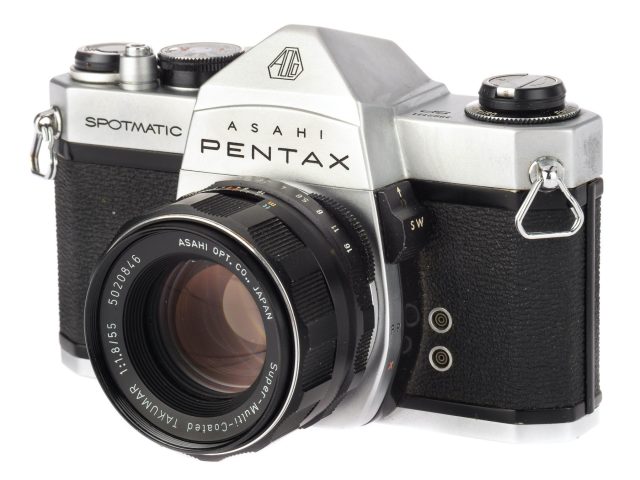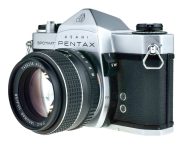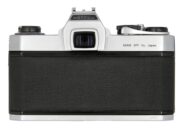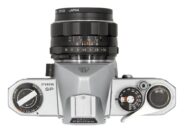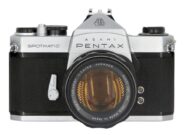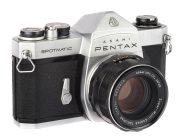Announced
Production status
System
Asahi Pentax M42 system cameras
- Asahi Pentax
- Asahi Pentax ES
- Asahi Pentax ES II
- Asahi Pentax K
- Asahi Pentax S
- Asahi Pentax S1
- Asahi Pentax S1a
- Asahi Pentax S2
- Asahi Pentax S3
- Asahi Pentax Spotmatic
- Asahi Pentax Spotmatic F
- Asahi Pentax Spotmatic II
- Asahi Pentax Spotmatic SL
- Asahi Pentax Spotmatic SP 1000
- Asahi Pentax Spotmatic SP 500
- Asahi Pentax SV
- Honeywell Pentax Spotmatic IIa
Asahi Pentax Spotmatic
aka Honeywell Pentax Spotmatic
35mm MF film SLR camera • Discontinued
Specification
| Format: | |
| 35mm full frame | |
Film type: | 135 cartridge-loaded film |
| M42 [45.5mm] | |
| Shutter: | |
Type: | Focal-plane |
Model: | Mechanical |
Speeds: | 1 - 1/1000 + B |
| Exposure: | |
Exposure metering: | Through-the-lens (TTL), stop-down |
Exposure modes: | Manual |
| Physical characteristics: | |
Weight: | 868g |
Dimensions: | 143x92x88mm |
Manufacturer description #1
The world's first single lens reflex camera with a behind-the-lens exposure system, the Spotmatic is the crowning achievement of the Honeywell Pentax line.
Introduced in 1964, its instantaneous popularity has since made it the number one single lens reflex in the world. Its classic design is human engineered to make it the lightest full-frame SLR with behind-the-lens metering available today. The controls are precisely located to match normal movements of the user's hands. Its no-nonsense shape combines precision and beauty into a timeless style.
Absolutely correct exposures are simple with the Spotmatic. Its CdS sensors read the light from the image focused on the ground glass - the same light that strikes the film itself. No matter which focal length lens is used, or whether filters, bellows or extension tubes are employed, the proper exposure is automatic and accurate. The Spotmatic also functions manually like other Pentax models.
The Spotmatic features: eye-level pentaprism finder with Fresnel lens; microprism and positive grid focusing; focal plane shutter; speeds from 1 to 1/1000 sec. plus Time; self timer; auto reset counter; ratchet film advance lever advances film and cocks shutter; FP and X flash terminals; very fast 50mm f/1.4 Super-Takumar lens or 55mm f/1.8 Super-Takumar lens.
Manufacturer description #2
There are many reasons why this has become the world's best-selling camera of its kind. The Honeywell Pentax Spotmatic combines the classic Pentax design, compact size with an uncannily accurate through-the-Iens fuII format metering system. It reads the in-focus image on the ground glass made by light passing through the taking aperture of the lens - exactly the same light the film sees. Regardless of the lens focal length, you're assured properly exposed pictures. You can forget about bracketing"insurance" shots and concentrate on the creative aspects.
Other features that assure you professional quality pictures with the Spotmatic include its bright, clear eye-level viewing system which makes composing and focusing easy even in dim light. And its convenience features such as built-in self-timer, automatic exposure counter reset and depth-of-field preview give you complete control over any picture situation.
See and hold the Spotmatic. Compare its "feel" to other expensive cameras. We think you'll agree it is in a class by itself.
Manufacturer description #3
When the Asahi Pentax Spotmatic was introduced to the public at the 1960 Photokina, the photographic world's fair in Cologne, Germany, it attracted immediate and keen attention. Not available for purchase at that time, it was a model of the advanced features and design that would be incorporated into cameras of the future.
Four years of extensive research, exhaustive experiments and intensive testing followed before it became available to serious amateur and professional photographers in late 1964.
With its unique behind-the-lens exposure meter of entirely new design, the Asahi Pentax Spotmatic is now more than just another camera... it is a new concept in photography.
Hidden within the camera body, its through-the-lens meter utilizes two highly sensitive Cadmium Sulphide sensors to accurately measure light seen by the camera's lens as it is reflected from the subject being photographed. Therefore, by measuring the light as it passes through the lens and matching the exposure needle as seen through the viewfinder, you can be assured of properly exposed pictures under all but the most impossible lighting conditions. Macro- or microphotography, pictures with telephoto lenses or with filters... the Asahi Pentax Spotmatic will give you correctly exposed photographs without the use of external meters or the need for cumbersome, time-consuming calculations!
The Spotmatic may also be set manually the same as any other quality 35mm camera if special lighting or selective focus effects are desired. Just leave the exposure meter switch in its OFF position and select the f/stop and speed settings for the required effect.
The traditional classic design and simple elegance associated with earlier models of the famous Asahi Pentax have been retained in the Spotmatic despite the incorporation of many highly advanced features. Meticulously constructed by master craftsmen, the Asahi Pentax cameras remain the standard of excellence and precision in the world of 35mm single-lens-reflex cameras.
You will find the Asahi Pentax Spotmatic even more versatile than the famous Asahi Pentax SV. Its new 50mm f/1.4 and 55mm f/1.8 Super-Takumar lenses with completely automatic diaphragm will satisfy the demands of even the most critical professional. Like the S1a and SV, the Asahi Pentax Spotmatic has a 42mm threaded lens mount that accepts any of the superb Takumar lenses from the ultra-wide-angle 18mm Takumar to the super-telephoto 1000mm Takumar.
***
TYPE: 35mm single-lens reflex with built-in light meter.
FILM AND PICTURE SIZE: 35mm film (20 or 36 exposures). 24mm x 36mm.
SHUTTER: Focal plane shutter, with single non-rotating dial. Speeds: B, 1-1/1000 sec. Film speed (ASA) setting dial and window on shutter speed dial. Built-in self-timer releases shutter in 5-13 seconds. Shutter curtains of special rubberized silk and eccentric cam for extremely high accuracy of shutter speeds, even in sub-zero temperatures.
WARNING SIGNAL: The index of shutter speeds turns to red when the shutter and film speed settings are off the meter's measurability range.
FINDER: Pentaprism finder with microprism Fresnel lens for instant focusing; 0.88x magnification with standard lens.
FOCUSING: Turn the distance scale ring until the subject image on the ground glass comes into focus.
REFLEX MIRROR: Instant return type with special shock absorbers for minimum vibrations.
FILM ADVANCE: Ratchet-type rapid wind lever (for film advance and shutter cocking). 10 deg. pre-advancing and 160 deg. advancing angle.
FILM EXPOSURE COUNTER: Automatic re-set type.
FILM REWIND: Rapid rewind crank for speedy film take-up. Film rewind release button on bottom of camera body rotates while film is being rewound.
LENS MOUNT: 42mm threaded lens mount.
FLASH SYNCHRONIZATION: Equipped with FP and X flash terminals. Electronic synchronization at 1/60 sec.
EXPOSURE METER: Built-in meter measures the brightness of the ground glass, and couples directly to shutter and film speed settings. Film speed (ASA) setting ranges from 20 to 1600 (LV1-18 for ASA-100 film with standard lens). Meter is powered with a mercury battery.
LOADED FILM INDICATOR: Loaded film reminder dial underneath film rewind knob is marked "PANCHRO" (black-and-white), "COLOR" and "EMPTY".
"COCKED" INDICATOR: A red disc appears in a small window alongside the shutter speed dial when the shutter is cocked, and blacks out when it is released.
Manufacturer description #4
This is America's best-selling fine camera.
Here's why:
In 1960, the world's first 35mm SLR with through-the-lens exposure meter made a sensational debut. It was the prototype of the Honeywell Pentax Spotmatic, introduced to the U.S. in the spring of 1965.
What happened in the five years between concept and reality? Plenty of hard work. The Pentax engineers knew they had developed a photographic breakthrough, but they had to satisfy themselves that it was perfect. So they explored methods of through-the-lens metering other than the Spotmatic's "full-format" control system. Every system on the market today was tried. And exhaustively tested. And ultimately, each method was discarded in favor of the system used in today's Honeywell Pentax Spotmatic - a system that is right for virtually all the pictures you will ever want to take.
The Spotmatic's foolproof, easy-to-use full format exposure control is a major reason for this best-selling camera's success. But a number of other things make the Spotmatic what it is.
Every owner knows of the superb results it delivers, and of the outstanding workmanship and mechanical perfection that make the Spotmatic such a delight to own and to use.
Just as important is the comprehensive Pentax System of fine Takumar lenses - 25 in all, from 17 to 1000mm - and useful accessories. It's a system you'll never outgrow, regardless of how far photography takes you.
Finally, there's the feeling you get when you hold a Pentax. It's a combination of compact size, light weight, and perfect balance, and it's difficult to put into words, but when you make a handling comparison between a Pentax and any other 35mm SLR, you'll know exactly what we mean.
With 50mm f/1.4 lens, the Spotmatic costs about $290, depending upon accessories; with 55mm f/1.8 lens, it's about $250.
Manufacturer description #5
The Honeywell Pentax Spotmatic is a success because of all the through-the-lens meter single-lens reflex cameras available, it alone offers all the following:
- An uncannily precise CdS metering system which reads the in-focus image on the ground glass made with the lens at taking aperture. In short, the Spotmatic's metering system measures exactly what the film sees - your assurance of perfect exposures with any focal length lens, filter, or close-up accessory, and under the most difficult lighting conditions.
- A metering system that's so easy to use it can be operated with one hand without taking your eye from the viewfinder.
- A size that maintains the Pentax tradition of a classic, compact, 35mm camera - still the lightest, smallest 35mm single-lens reflex available.
- A price of just $289.50, complete with the superb new Super-Takumar 50mm f/1.4 lens - a lens that's being hailed by the experts as one of the finest in the world.
The Honeywell Pentax Spotmatic also features a redesigned focal plane shutter with ultra-accurate speed control (to 1/1000 second); a new ratchet-type film advance lever; a new camera back lock, and a new, more convenient, built-in self timer. And, all these new features are in addition to the standard features retained from earlier models of the Honeywell Pentax. Such features as focusing to 18", fully automatic lens diaphragm with depth-of-field preview feature; exposure counter with automatic reset, and many, many more.
All this, plus outstanding workmanship and attention to detail that have few equals in the fine-camera field make the Honeywell Pentax Spotmatic the finest camera value in the world today.
From the editor
The weight and dimensions are indicated for the camera body with the standard lens mounted.
Special editions (1)
- Asahi Pentax Spotmatic Gold - 1970
Similar cameras (151)
35mm full frame • Manual focus • Film • Singe-lens reflex • M42 mount
| Model | Shutter | Metering | Modes | Year |
|---|---|---|---|---|
| Alpa Si 2000 | E, 1/2000 | TTL • WA | AM | 1977 ● |
| Argus CR-3E | E, 1/2000 | TTL • WA | M | ● |
| Argus/Cosina STL 1000 | M, 1/1000 | TTL • WA | M | 1970 ● |
| Chinon AM-3 | M, 1/1000 | TTL • WA | M | ● |
| Chinon CE II Memotron | E, 1/2000 | TTL • WA | AM | 1975 ● |
| Chinon CE Memotron | E, 1/2000 | TTL • WA | AM | 1973 ● |
| Chinon CE-3 Memotron | E, 1/1000 | TTL • WA | AM | 1977 ● |
| Chinon CM-1 | M, 1/1000 | TTL • WA | M | ● |
| Chinon CM-3 | M, 1/1000 | TTL • WA | M | 1977 ● |
| Chinon CS | M, 1/1000 | TTL • WA | M | 1976 ● |
| Chinon CS-4 | M, 1/1000 | TTL • WA | M | ● |
| Chinon CX | M, 1/1000 | TTL • WA | M | ● |
| Chinon CX II | M, 1/1000 | TTL • WA | M | 1976 ● |
| Chinon LED Promaster | M, 1/1000 | TTL • WA | M | ● |
| Chinon M-1 | M, 1/1000 | TTL • WA | M | 1973 ● |
| Chinon SLR | M, 1/1000 | TTL • WA | M | 1979 ● |
| Chinonflex TTL | M, 1/1000 | TTL • WA | M | ● |
| Contax D aka ConSol aka HEXACON aka Pentacon |
M, 1/1000 | -- | M | 1951 ● |
| Contax E aka Pentacon E |
M, 1/1000 | Window | M | 1956 ● |
| Contax F aka Pentacon F |
M, 1/1000 | -- | M | 1956 ● |
| Contax FB aka Pentacon FB |
M, 1/1000 | Window | M | 1956 ● |
| Contax FBM aka Pentacon FBM |
M, 1/1000 | Window | M | 1958 ● |
| Contax FM aka Pentacon FM |
M, 1/1000 | -- | M | 1958 ● |
| Contax S | M, 1/1000 | -- | M | 1949 ● |
| Cosina 1000S | M, 1/1000 | TTL • WA | M | 1975 ● |
| Cosina 4000S aka Vivitar 400/SL |
M, 1/1000 | TTL • WA | M | 1976 ● |
| Cosina CSL / CSM aka Vivitar XC-3 |
E, 1/1000 | TTL • WA | M | 1977 ● |
| Cosina CSR aka Vivitar XC-2 |
E, 1/1000 | TTL • WA | M | 1976 ● |
| Cosina Hi-Lite | M, 1/1000 | TTL • WA | M | 1968 ● |
| Cosina Hi-Lite 202 aka Vivitar 220/SL |
M, 1/1000 | TTL • WA | M | 1975 ● |
| Cosina Hi-Lite 205 aka Vivitar 250/SL |
M, 1/1000 | TTL • WA | M | 1976 ● |
| Cosina Hi-Lite 402 aka Vivitar 420/SL |
M, 1/1000 | TTL • WA | M | 1975 ● |
| Cosina Hi-Lite 405 aka Vivitar 450/SLD |
M, 1/1000 | TTL • WA | M | 1975 ● |
| Cosina Hi-Lite DL / DLR aka Edixa 2MTL |
M, 1/1000 | TTL • WA | M | 1970 ● |
| Cosina Hi-Lite EC aka Argus/Cosina EC 2000 |
E, 1/2000 | TTL • WA | AM | 1972 ● |
| Cosina Voigtlander Bessaflex TM | M, 1/2000 | TTL • WA | M | 2003 ● |
| Exa 1b aka Exa 1c |
M, 1/175 | -- | M | 1977 ● |
| Exakta FE 2000 | M, 1/1000 | TTL • OA | SM | 1976 ● |
| Exakta TL 1000 | M, 1/1000 | TTL • WA | M | 1976 ● |
| Exakta TL 500 | M, 1/500 | TTL • WA | M | 1975 ● |
| Exakta Twin TL 42 | M, 1/1000 | TTL • WA | M | ● |
| Fujica AZ-1 | E, 1/1000 | TTL • OA | AM | 1977 ● |
| Fujica ST601 | M, 1/700 | TTL • WA | M | 1975 ● |
| Fujica ST605 | M, 1/700 | TTL • WA | M | 1976 ● |
| Fujica ST605 II | M, 1/700 | TTL • OA | M | 1978 ● |
| Fujica ST605N | M, 1/700 | TTL • WA | M | 1978 ● |
| Fujica ST701 | M, 1/1000 | TTL • WA | M | 1970 ● |
| Fujica ST705 | M, 1/1500 | TTL • OA | M | 1976 ● |
| Fujica ST705W | M, 1/1500 | TTL • OA | M | 1978 ● |
| Fujica ST801 | M, 1/2000 | TTL • OA | M | 1972 ● |
| Fujica ST901 | E, 1/1000 | TTL • OA | AM | 1974 ● |
| Mamiya DSX 1000 | M, 1/1000 | TTL • OA | M | 1974 ● |
| Mamiya DSX 1000B | M, 1/1000 | TTL • OA | M | 1975 ● |
| Mamiya DSX 500 | M, 1/500 | TTL • OA | M | 1974 ● |
| Mamiya MSX 1000 | M, 1/1000 | TTL • OA | M | 1974 ● |
| Mamiya MSX 500 | M, 1/500 | TTL • OA | M | 1974 ● |
| Mamiya/Sekor 1000 DTL | M, 1/1000 | TTL • WA | M | 1968 ● |
| Mamiya/Sekor 1000 TL | M, 1/1000 | TTL • WA | M | 1966 ● |
| Mamiya/Sekor 2000 DTL | M, 1/2000 | TTL • WA | M | 1969 ● |
| Mamiya/Sekor 500 DTL | M, 1/1000 | TTL • WA | M | 1968 ● |
| Mamiya/Sekor 500 TL | M, 1/500 | TTL • WA | M | 1966 ● |
| Mamiya/Sekor CP aka Mamiya/Sekor CWP |
M, 1/1000 | Window | M | 1964 ● |
| Olympus FTL | M, 1/1000 | TTL • OA | M | 1970 ● |
| Pentacon super | M, 1/2000 | TTL • OA | M | 1968 ● |
| Pentaflex SL | M, 1/500 | -- | M | 1967 ● |
| Petri Penta | M, 1/500 | -- | M | 1959 ● |
| Praktica | M, 1/500 | -- | M | 1949 ● |
| Praktica DTL 2 | M, 1/1000 | TTL • WA | M | 1978 ● |
| Praktica DTL 3 | M, 1/1000 | TTL • WA | M | 1979 ● |
| Praktica EE 2 | E, 1/1000 | TTL • OA | AM | 1977 ● |
| Praktica EE 3 | E, 1/1000 | TTL • OA | AM | 1979 ● |
| Praktica FX aka Praktiflex FX |
M, 1/500 | -- | M | 1952 ● |
| Praktica FX 2 aka Praktica FX 3 |
M, 1/500 | -- | M | 1956 ● |
| Praktica III | M, 1/500 | -- | M | 1955 ● |
| Praktica IV (early) | M, 1/500 | -- | M | 1959 ● |
| Praktica IV (late) | M, 1/500 | -- | M | 1960 ● |
| Praktica IV B | M, 1/500 | Window | M | 1961 ● |
| Praktica IV BM | M, 1/500 | Window | M | 1961 ● |
| Praktica IV F | M, 1/500 | -- | M | 1963 ● |
| Praktica IV FB | M, 1/500 | Window | M | 1963 ● |
| Praktica IV M | M, 1/500 | -- | M | 1961 ● |
| Praktica L aka Praktica autoreflex S |
M, 1/1000 | -- | M | 1969 ● |
| Praktica L 2 | M, 1/1000 | -- | M | 1975 ● |
| Praktica LB aka Praktica autoreflex SL |
M, 1/1000 | Window | M | 1972 ● |
| Praktica LB 2 | M, 1/1000 | Window | M | 1976 ● |
| Praktica LLC | M, 1/1000 | TTL • OA | M | 1969 ● |
| Praktica LTL aka Praktica autoreflex S-TL |
M, 1/1000 | TTL • WA | M | 1970 ● |
| Praktica LTL 2 | M, 1/1000 | TTL • WA | M | 1975 ● |
| Praktica LTL 3 | M, 1/1000 | TTL • WA | M | 1975 ● |
| Praktica mat | M, 1/1000 | TTL • WA | M | 1965 ● |
| Praktica MTL 3 | M, 1/1000 | TTL • WA | M | 1978 ● |
| Praktica MTL 5 | M, 1/1000 | TTL • WA | M | 1983 ● |
| Praktica MTL 50 | M, 1/1000 | TTL • WA | M | 1985 ● |
| Praktica MTL 5B aka Praktica MTL NOVA B aka Praktica TL 5B |
M, 1/1000 | TTL • WA | M | 1985 ● |
| Praktica nova | M, 1/500 | -- | M | 1964 ● |
| Praktica nova B | M, 1/500 | Window | M | 1965 ● |
| Praktica PL electronic | E, 1/500 | -- | M | 1967 ● |
| Praktica PL nova I | M, 1/500 | -- | M | 1967 ● |
| Praktica PL nova IB | M, 1/500 | Window | M | 1967 ● |
| Praktica PLC 2 | M, 1/1000 | TTL • OA | M | 1975 ● |
| Praktica PLC 3 | M, 1/1000 | TTL • OA | M | 1978 ● |
| Praktica super TL | M, 1/500 | TTL • WA | M | 1968 ● |
| Praktica super TL 2 aka Praktica 1000 |
M, 1/500 | TTL • WA | M | 1975 ● |
| Praktica super TL 3 | M, 1/500 | TTL • WA | M | 1978 ● |
| Praktica super TL1000 aka Praktica MTL 3 aka Praktica MTL 5 aka Praktica NOVA II aka Praktica PM 3 aka Praktica TL 3 |
M, 1/1000 | TTL • WA | M | 1980 ● |
| Praktica super TL500 | M, 1/500 | TTL • WA | M | 1981 ● |
| Praktica V F | M, 1/500 | -- | M | 1964 ● |
| Praktica V FB | M, 1/500 | Window | M | 1965 ● |
| Praktica VLC | M, 1/1000 | TTL • OA | M | 1974 ● |
| Praktica VLC 2 | M, 1/1000 | TTL • OA | M | 1976 ● |
| Praktica VLC 3 | M, 1/1000 | TTL • OA | M | 1976 ● |
| Ricoh Auto TLS EE | M, 1/1000 | TTL • OA | SM | 1976 ● |
| Ricoh Singlex II | M, 1/1000 | TTL • WA | M | 1976 ● |
| Ricoh Singlex TLS | M, 1/1000 | TTL • WA | M | 1967 ● |
| Ricoh SLX 500 | M, 1/500 | TTL • WA | M | 1975 ● |
| Ricoh TLS 401 | M, 1/1000 | TTL • WA | M | 1970 ● |
| Sigma Mark-I | M, 1/1000 | TTL • WA | M | 1975 ● |
| Voigtlander VSL1 (TM) aka Ifbaflex M 102 |
M, 1/1000 | TTL • OA | M | 1974 ● |
| Yashica Electro AX | E, 1/1000 | TTL • WA | AM | 1972 ● |
| Yashica FFT | M, 1/1000 | TTL • WA | M | 1973 ● |
| Yashica J-3 | M, 1/500 | Window | M | 1962 ● |
| Yashica J-4 | M, 1/500 | Window | M | 1965 ● |
| Yashica J-5 | M, 1/1000 | Window | M | 1964 ● |
| Yashica J-7 | M, 1/1000 | Window | M | 1966 ● |
| Yashica J-P | M, 1/500 | -- | M | 1964 ● |
| Yashica Penta J aka Yashica Reflex 35 |
M, 1/500 | -- | M | 1961 ● |
| Yashica TL | M, 1/500 | TTL • WA | M | 1968 ● |
| Yashica TL Electro X | E, 1/1000 | TTL • WA | M | 1968 ● |
| Yashica TL Electro X ITS | E, 1/1000 | TTL • WA | M | 1970 ● |
| Yashica TL-E | M, 1/500 | TTL • WA | M | 1969 ● |
| Yashica TL-Electro | M, 1/1000 | TTL • WA | M | 1972 ● |
| Yashica TL-Super | M, 1/1000 | TTL • WA | M | 1966 ● |
| Zeiss Ikon Icarex 35 (TM) | M, 1/1000 | -- | M | 1969 ● |
| Zeiss Ikon Icarex 35S (TM) | M, 1/1000 | TTL • OA | M | 1969 ● |
| Zeiss Ikon SL706 | M, 1/1000 | TTL • OA | M | 1971 ● |
| Zenit-10 aka Зенит-10 |
M, 1/500 | Window | M | 1982 ● |
| Zenit-11 aka Зенит-11 |
M, 1/500 | Window | M | 1982 ● |
| Zenit-122[V] aka Зенит-122[В] |
M, 1/500 | TTL • WA | M | 1990 ● |
| Zenit-12sd aka Zenit-12xp aka Зенит-12сд |
M, 1/500 | TTL • WA | M | 1983 ● |
| Zenit-15M | M, 1/500 | TTL • WA | M | ● |
| Zenit-16 aka Зенит-16 |
M, 1/1000 | TTL • OA | M | 1975 ● |
| Zenit-18 aka Зенит-18 |
E, 1/1000 | TTL • OA | AM | 1980 ● |
| Zenit-19 aka Зенит-19 |
E, 1/1000 | TTL • WA | M | 1979 ● |
| Zenit-312m | M, 1/500 | TTL • WA | M | 1999 ● |
| Zenit-412DX | M, 1/500 | TTL • WA | M | 2000 ● |
| Zenit-412LS | M, 1/500 | TTL • WA | M | 2002 ● |
| Zenit-E aka Зенит-Е |
M, 1/500 | Window | M | 1965 ● |
| Zenit-EM aka Зенит-ЕМ |
M, 1/500 | Window | M | 1972 ● |
| Zenit-ET aka Зенит-ЕТ |
M, 1/500 | Window | M | 1981 ● |
| Zenit-TTL aka Zenit-12 aka Зенит-12 aka Зенит-TTL |
M, 1/500 | TTL • WA | M | 1978 ● |
| Zenit-V aka Зенит-В |
M, 1/500 | -- | M | 1968 ● |
